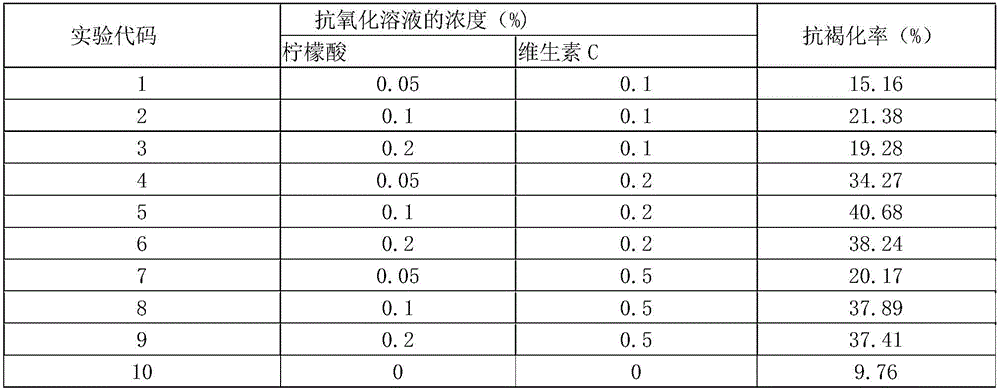Method for inhibiting browning of perennial Mongolian oak explants
A technology of explants and Quercus mongolica, which is applied in botany equipment and methods, horticultural methods, plant regeneration, etc., can solve the problems that seedlings cannot maintain good properties, difficult to root, and the survival rate of perennial Quercus mongolica cuttings is low.
- Summary
- Abstract
- Description
- Claims
- Application Information
AI Technical Summary
Problems solved by technology
Method used
Image
Examples
Embodiment 1
[0045] 1. Effects of different concentrations of antioxidant solutions on browning of perennial Quercus mongolica explants
[0046] The sterilized explants were cut and soaked in different concentrations of antioxidant solutions for 10 minutes, then inoculated on WPM (blank) medium, and the anti-browning rate was investigated after 7 days. The results are shown in Table 1.
[0047]
[0048] Table 1 Effects of different concentrations of antioxidant solutions on browning of perennial Quercus mongolica explants
[0049]
[0050] It can be seen from Table 1 that different concentrations of antioxidant solutions have different anti-browning effects on perennial Quercus mongolica explants, and the mixed solution of 0.1% citric acid and 0.2% vitamin C has the best effect on inhibiting the browning of explants. The anti-browning rate reaches 40.68%, and the anti-browning effect of 0.2% citric acid and 0.2% vitamin C mixture can also reach 38.24%. The anti-browning rate of expl...
Embodiment 2
[0052] 2. Effect of soaking time of explants in antioxidant solution on browning of perennial Quercus mongolica explants
[0053] The sterilized explants were soaked in 0.1% citric acid and 0.2% vitamin C mixture for 5min, 10min, 15min, 20min, 30min respectively, and then inoculated on WPM (blank) medium, and the browning was investigated after 10 days. The results are shown in Table 2
[0054] Table 2 Effects of different soaking times on browning of perennial Quercus mongolica explants
[0055]
[0056]
[0057] It can be seen from Table 2 that when the soaking time is 15 minutes, the anti-browning rate of the explants is the highest, and the anti-browning rate of the explants decreases after 20 minutes. It shows that soaking in antioxidant solution for too long will cause damage to explants.
Embodiment 3
[0059] 3. Effect of basic medium on browning of perennial Quercus mongolica explants
[0060] Soak the sterilized explants with antioxidant solution (0.1% citric acid and 0.2% vitamin C mixture) for 15 minutes and then inoculate them on different basic medium, the additional components of which are 6-benzylaminopurine 1.0mg / L, 6-furfurylaminopurine 2.0mg / L, α-naphthaleneacetic acid 0.5mg / L. Investigate the brown mortality rate after 10 days, and investigate the induction rate after 14 days.
[0061]
[0062] Table 3 Effects of different basal media on browning of perennial Quercus mongolica explants
[0063] experimental code basic medium Anti-browning rate (%) Induction rate (%) growth state 16 WPM 43.79 35.24 robust, bright green leaves 17 1 / 2WPM 46.87 39.47 robust, bright green leaves 18 MS 30.12 18.17 robust, bright green leaves 19 HB 32.47 10.23 Robust, yellow-green leaves
[0064] It can be seen from Table...
PUM
 Login to View More
Login to View More Abstract
Description
Claims
Application Information
 Login to View More
Login to View More - R&D
- Intellectual Property
- Life Sciences
- Materials
- Tech Scout
- Unparalleled Data Quality
- Higher Quality Content
- 60% Fewer Hallucinations
Browse by: Latest US Patents, China's latest patents, Technical Efficacy Thesaurus, Application Domain, Technology Topic, Popular Technical Reports.
© 2025 PatSnap. All rights reserved.Legal|Privacy policy|Modern Slavery Act Transparency Statement|Sitemap|About US| Contact US: help@patsnap.com



